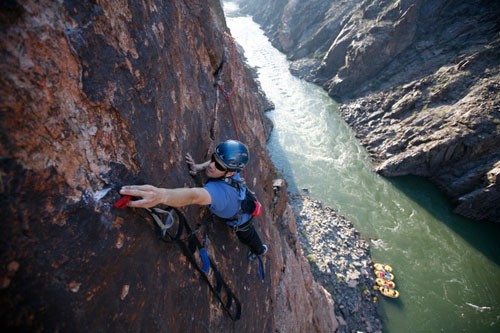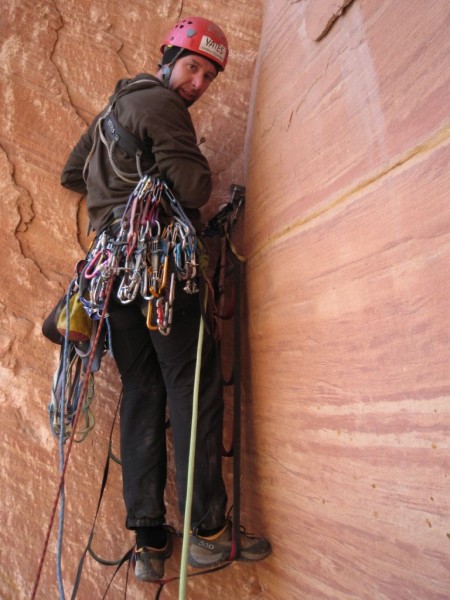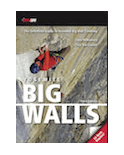A big wall typically takes more than two days to climb, is at least 800 feet tall and presents a steep face. Big walls require traditional climbing skills with the additional technique of hauling your camping gear behind you as well as sleeping on the wall. The most famous big wall is the world is El Capitan in Yosemite National Park. It is 2900 feet tall and requires most teams to spend three nights on the wall where they sleep on natural ledges on the face or on collapsible hanging cots called portaledges.
Almost all big walls require aid climbing, which is placing gear in the rock that you then stand on using webbing ladders to reach up as high as you can and place the next piece of gear. Aid climbing is different than free climbing where the gear is not used for upward progress; it is just there in case you fall. Aid climbing technique is used on a big wall where either free climbing is impossible or too difficult for the leader.
What is the big wall experience like?
Big wall climbing is all about vertical exposure. It is about climbing and sleeping with thousands of feet of air below you, and thousands of feet of rock above you. There is nothing else like it. It is not about summit glory, or pulling a single hard move or seeking a release of adrenaline (although all three of those things will happen). It is a much more complex and rich experience. It is like taking a camping trip to the most exciting place in the world—a place where gravity and vertical exposure will not relent. You don’t flirt with gravity like you might while BASE jumping or doing a hard single pitch climb. You live with it…24 hours a day.
Big wall climbing requires the most amount of gear of any type of climbing. You must have gear for any type of crack and also gear for living on the wall like a portaledge and haulbag. Below is a photo of a typical big wall rack used for climbing el Capitan.
How do you start big wall climbing?
The path to becoming a traditional climber usually looks like this:
• Become a proficient traditional climber capable of leading many multi-pitch climbs that are rated 5.9 and 5.10.
• Team up with a guide or proficient aid climber who can teach you all the big wall techniques (jumaring, aid climbing, hauling).
• Spend months mastering the techniques by practicing aid climbing.
• Do some mock gear leads on top rope, placing as much gear as possible (link to mock leading). Then have an experienced traditional climber follow your pitch and critique your gear placements.
A great overview of the path to becoming a big wall climber can be found in the SuperTopo Guidebook Road to The Nose







